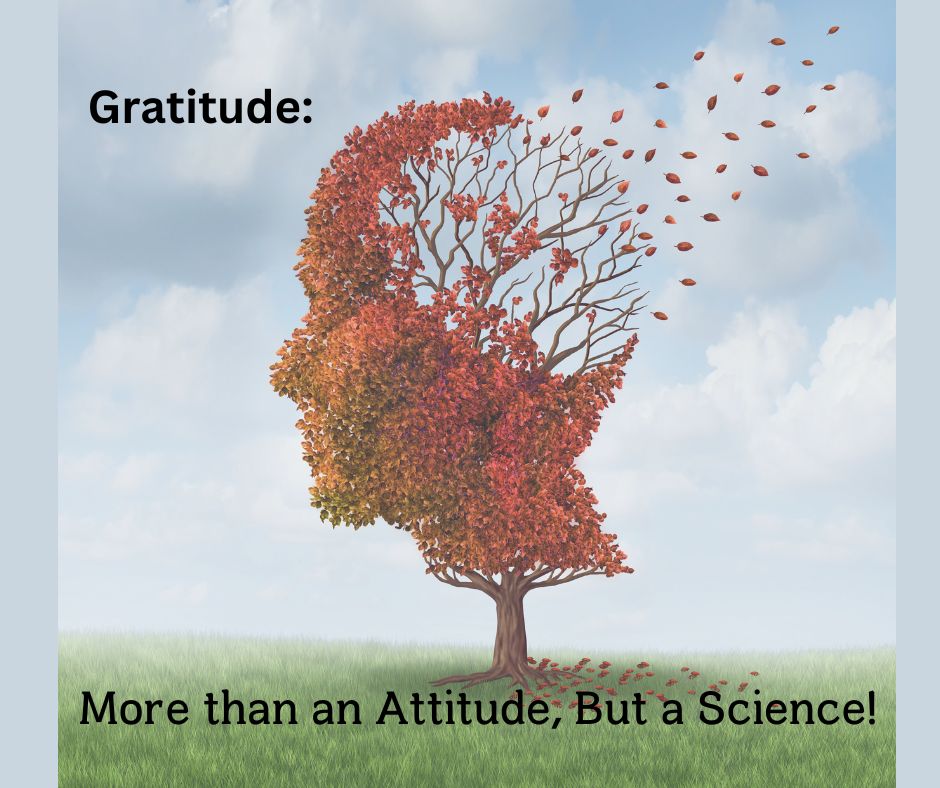Your cart is currently empty!
Gratitude: More than an Attitude, But a Science.
Published by
on

November seems to be synonymous with an “Attitude of Gratitude” and practicing being thankful for everything in your life. However, sometimes that can come off as invalidating, especially if one is going through a hard time! An Attitude of Gratitude is not a fad or promotion of toxic positivity (though it sometimes feels that way) but a well-being practice based in science.
According to the National Science Foundation in 20051, the average person experiences about 60,000 thoughts a day. New research from Queen’s University, Canada2, further identified thoughts as “moments being fixed on the same idea”; and discovered we have about 6,200 thought transitions a day. Regardless of how these studies measured “thought”, they both agreed that of the many numerous thoughts we have, roughly 80% are negative in nature and 90-95% are repetitive due to our survival wiring.

Our brain’s primary purpose is to keep us safe and alive; meaning, it looks for anything that can cause us harm physically, mentally, emotionally and socially.
The potential impact, often in difficult circumstances, we default focus on the hard parts, the uncomfortable feelings and the overwhelming suck of the situation. Which can further weigh us down and complicate our recovery, growth and resilience.
Now, I am not saying we ignore the hard and traumatic situations in life and just look for sunshine and rainbows. A coach I had once pointed out that being happy 100% of the time was impossible, life is 50% awesomeness and 50% absolute suck. You need both to truly value the other. If you’ve experienced trauma at any point in your life- this statement can come off as offensive. As caregivers, we never want to see another being suffer, so recognizing that trauma does and is going to happen, can be downright unfair. Growing through our trauma or letting go of the wrong in the world, to see the good can be even harder.
When we hold on to these thoughts, they continue to cause injury to us beyond the event(s). They impact our overall wellbeing and resiliency for when the next hard thing comes along (and it will). It leaves us in a pit with no ladder out. Depending on how deep your pit, a gratitude practice alone is probably not going to help you out and seeking support from professionals is extremely important.
Having a gratitude practice focuses on retraining/rewiring the brain from its default negativity bias to a more optimistic outlook. Allowing us to effectively and efficiently process, recover and build resilience during challenging events. Our brain, while not a muscle, still needs exercise, especially the prefrontal cortex, where logic, response, focus, problem solving, and emotional regulation live.

What I often see, and am guilty of myself, is jumping from “this is a trauma” to trying to write or say the statement “I am grateful for…” while still in the trauma. I will be honest; I haven’t personally seen this version of gratitude work and often creates a bad taste for any gratitude practice in the future.
So how does one start or have a gratitude practice:
- Start gratitude practice when you are not actively in a traumatic situation. Focus on working with a trained professional to process and begin healing.
- Start small, use approximations. Example: “Today was a hard day, I’m exhausted, and I made it through.” or “Things did not go the way I wanted, it sucks, and I am working to accept that”
- Build it into your daily routine. Whether it be first thing in the morning, throughout your day or even before climbing into bed.
- Can use gratitude journals, prompts, lists or simply say things each day. Gratitude is unique to each person; your practice may look different from someone else and that is awesome.
- Give yourself grace during the hard times and when you forget. This is a “practice”, meaning it is not a requirement, it is imperfect at times, there is no right or wrong way to do it.
Inspiring, Challenging and Empowering Always,
Shannon
References:
- National Science Foundation, 2005, https://www.nsf.gov/
- Tseng, J., Poppenk, J. Brain meta-state transitions demarcate thoughts across task contexts exposing the mental noise of trait neuroticism. Nat Commun 11, 3480 (2020). https://doi.org/10.1038/s41467-020-17255-9

Leave a Reply